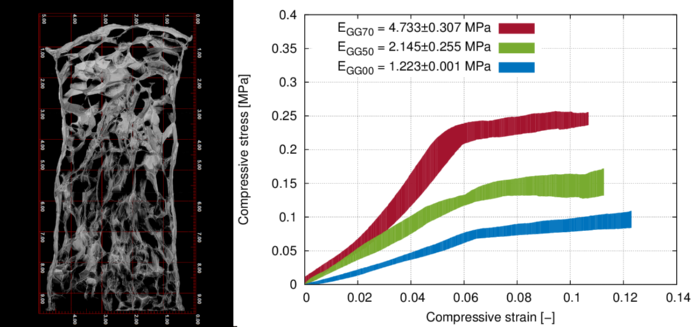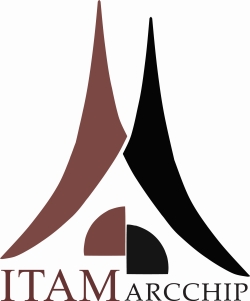People
Doktor Tomáš, Ing., Laboratoy of Biomechanics
Fíla Tomáš, Ing., Laboratoy of Biomechanics
Jiroušek Ondřej, prof. Ing., PhD, Department of Biomechanics
Koudelka Petr, Ing., Laboratoy of Biomechanics
Krčmářová Nela, Ing., Department of Biomechanics
Kytýř Daniel, Ing., PhD., Laboratoy of Biomechanics, head of the department
Šleichrt Jan, Ing. Laboratoy of Biomechanics
Zlámal Petr, Ing., Laboratoy of Biomechanics, head of the laboratory
Description of activities
The research carried out in the department and laboratory of biomechanics focuses on the experimental determination of mechanical properties of biological tissues and the artificial biocompatible structures used in regenerative medicine as well as the development of material models of tissues and their implementation in numerical simulations. One of their main objectives is to apply engineering principles to the development of orthopedic implants and tissue scaffolds, including the analysis of their interactions with the surrounding tissues. Other activities include the development of specialized experimental equipment and software for detailed biomechanical analysis of the materials studied. Moreover, the laboratory provides facilities for the design, commissioning and testing of such equipment.
News
At present, the Laboratory of Biomechanics is carrying out work associated with the international projects Interreg ATCZ133 (Kompetenzzentrum MechanoBiologie in Regenerativer Medizin) and ATCZ38 (Competence Center for High-Resolution 3D X-ray Imaging). These projects, with support from our laboratory, involve development of a compact uniaxial loading device suitable for experiments using radiographic methods. The device under construction also includes a chamber for loading the sample, which makes it possible to maintain stable fluid circulation at the selected temperature to simulate the natural environment for biological samples during experiments. Another device being developed is an instrument for the optical and mechanical analysis of samples examined in individual cross sections using the method of gradual abrasion (by micrometric layers) and micro-indentation. Another unique device, which is currently in the pilot testing stage, is a loading machine for four-point bending test. Its design allows it to be used in combination with radiographic methods and also with large samples (up to 300 mm in length).
ITAM is a founding member of the Competence Center for Mec and Regenerative Medicine
As part of the international cooperation supported by the international project InterReg ATCZ133 from 2017 to 2019, ITAM with its partner institutions Donau Universität Krems, Ludwig Boltzmann Gesellschaft Wien, Technische Universität Wien, South Bohemian University in České Budějovice and St. Anna University Hospital in Brno is participating in building a new competence center in the fields of mechanobiology (the study of the responses of cells and tissues to the environment) and regenerative medicine. Through the center, the partners will share unique research infrastructure, building a platform for communication and knowledge transfer based on an information system for data backup, sharing and processing.
Intensive research in the field of mechanobiological aspects of cells and tissues is of the highest clinical and socio-economic significance as these stimuli are crucial for the natural preservation of bones, cartilage and muscles (including cardiac muscle). Innovative mechanobiological approaches form the basis for new procedures in prevention and regeneration. The research objectives include utilizing the human body's self-healing power to restore dysfunctional cells and tissues, which represents relatively low-cost methods, reducing the costs of treatment. These approaches can replace expensive long-term pharmacological treatments or series of sequential surgical procedures.
Within the project, the teams of the Laboratory of Biomechanics and Laboratory of X-ray Tomography will develop experimental methods for studying the behaviour of tissues and their substitutions (see the figure), diagnostic methods, and tools for computer simulation of these processes.

Figure: Visualization of the internal microstructure of a tissue scaffold using high-resolution microtomography (left).
Envelope chart showing the dependence of stress on tissue scaffold strain with different proportions of bioactive reinforcing nanoparticles (right).
Research and equipment
Within the on-going projects, mainly mechanical properties of artificial tissue scaffold structures are researched using the existing laboratory equipment through micromechanical loading tests and radiographic methods. Based on the experiments performed, computing methods (FEM modelling, digital volume correlation methods, etc.) are applied to determine the mechanical properties of the structure being studied.
Equipment (existing):
- Uniaxial loading device for radiographic measurements up to 10 kN (proprietary design)
- Uniaxial loading device for radiographic measurements up to 0,5 kN (proprietary design)
- High-precision 3-axis laboratory table (proprietary design)
- CCD camera with telecentric lens
- Modular unit for controlling experimental devices (proprietary design)
- Instron 4301 loading bench with temperature chamber
- Loading device for creep tests (proprietary design)
Equipment (in development/production):
- Loading device for four-point bending test for radiographic measurements (proprietary design, patent bending)
- Equipment for optical and mechanical analyses using grinding (proprietary design)
- Uniaxial loading device for radiographic measurements with optional chamber for biological samples up to 3 kN (proprietary design)
Projects
Current:
- Interreg ATCZ133 (Kompetenzzentrum MechanoBiologie in Regenerativer Medizin)
- Interreg ATCZ38 (Competence Center for High-Resolution 3D X-ray Imaging)
Successfully completed:
- Grant by the Czech Science Foundation No. P105/12/0824: Determination of structural and mechanical properties of metal foams using nanoindentation, microstructural FEM models and mechanical tests
- Grant by the Czech Science Foundation No. P105/10/2305: Morphometric and mechanical properties of the trabecular bone determined using micromechanical and numerical modelling methods
D. Kytýř, P. Zlámal



